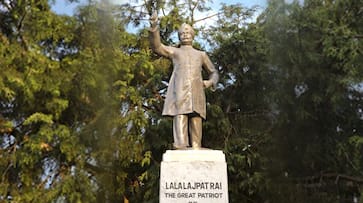Lala Lajpat Rai is one of the Lal Bal Pal trio who fought for the freedom of India. Lajpat Rai also used his writing to educate Indians and fight against the British rule. Here is looking into the life of freedom fighter Lala Lajpat Rai through eight books he authored.
New Delhi: One of the greatest freedom fighters of India, Lala Lajpat Rai popularly known as Punjab Kesari died on November 17 in 1928. He reportedly died of a heart attack.
Lala Lajpat Rai along with Bal Gangadhar Tilak, and Bipin Chandra Pal played a pivotal role in attempting to free India from the British rule in the early 20th century. The trio were known as Lal Bal Pal.
Lala Lajpat Rai was born on January 28, 1865 to a Hindu Aggarwal family. He was a son of Urdu and Persian government schoolteacher Munshi Radha Krishan Agrawal and Gulab Devi Agrawal, at Dhudike in Punjab. He married Radha Devi Agrawal and had two sons, Amrit Rai Agrawal and Pyarelal Agrawal, and a daughter, Parvati Agrawal.
Rai's liberal views and belief in Hinduism were shaped by his father and deeply religious mother. He successfully applied this to create a career of reforming the religion and Indian policy through politics and journalistic writing.
Apart from being the founder editor of Arya Gazette, Lala Lajpat Rai authored eight books that were his own experiences in British India.
Here is a glimpse into books he authored.
The Story of My Deportation (1908):
This book is the story of Lala Lajpat Rai's life in exile at Mandalay. He speaks about the causes that led to mounting discontentment In Punjab in 1907. His comments on various stirring incidents at Mandalay also provide an insight into his ideologies and life.
Arya Samaj (1915):
The Arya Samaj rituals are considered important in the life of a devout Hindu. Among the innumerable castes and communities in India, only the trivargeas - Brahmanas, Kshatriyas and Vaishyas perform their rites strictly in accordance with the injunctions ordained by the Vedas, states the book authored by Lala Lajpat Rai.
The United States of America: A Hindu’s Impression (1916):
This book is an excerpt in which Rai contemplates the real nature of “civilization". Explaining his ideas of western civilization after witnessing it in the US, Lala Lajpat Rai writes: "Now there is a reaction and the materialistic civilization of the West is at their door. The choice lies between extinction and Europeanisation, unless they can find out a means by which they may be able to retain the best parts of both and evolve a new and a more humane civilization of their own."
The problem of National Education in India (1920):
It is a special study of education as a science. This book is meant for lay readers. Its object is to educate the people in ‘The problem of National Education in India’ and to help the people in the formation of public opinion, says Rai in the book.
Unhappy India (1928):
Lala Lajpat Rai dedicated this book to "those numberless American men and women who stand for the freedom of the world; who know no distinctions of colour, race or creed; and who profess a religion of love, humanity and justice. To them the oppressed people of the earth look for sympathy in their struggle for emancipation, and in them is centred the hope of world-peace."
England's Debt to India (1917):
This book is dedicated to those brave, high minded, and honest Englishmen and Englishwomen who did not hesitate to speak the truth about the effects of the British rule in India, though by doing so they earned the dislike of their countrymen. this book is based on the testimony of these people.
Autobiographical Writings:
Lajpat Rai had written his autobiography in fragments which mostly remained unpublished during his lifetime. His autobiography is a compilation from The Story of My Life, The Story of My Deportation and the Indian Revolutionaries in the United States and Japan. These three fragments provide an authentic and trustworthy account of his active public life in the political, social, religious and economic development of the country.
Young India: An Interpretation and a History of the Nationalist Movement from Within (1916)
This book was written shortly after World War I broke out in Europe. Rai wrote the book to exclaim his people's desire to help the British, who had been ruling in India since the mid-1700s, fight against the Germans. While the book makes the Indian people sound good, saying that they were rushing in masses to volunteer for war, one must take what Rai says with a grain of salt. Rai was trying to gain American support in India against British colonialism through this writing.
Last Updated Nov 17, 2019, 1:39 PM IST









![Salman Khan sets stage on fire for Anant Ambani, Radhika Merchant pre-wedding festivities [WATCH] ATG](https://static-gi.asianetnews.com/images/01hr1hh8y86gvb4kbqgnyhc0w0/whatsapp-image-2024-03-03-at-12-24-37-pm_100x60xt.jpg)
![Pregnant Deepika Padukone dances with Ranveer Singh at Anant Ambani, Radhika Merchant pre-wedding bash [WATCH] ATG](https://static-gi.asianetnews.com/images/01hr1ffyd3nzqzgm6ba0k87vr8/whatsapp-image-2024-03-03-at-11-45-35-am_100x60xt.jpg)


